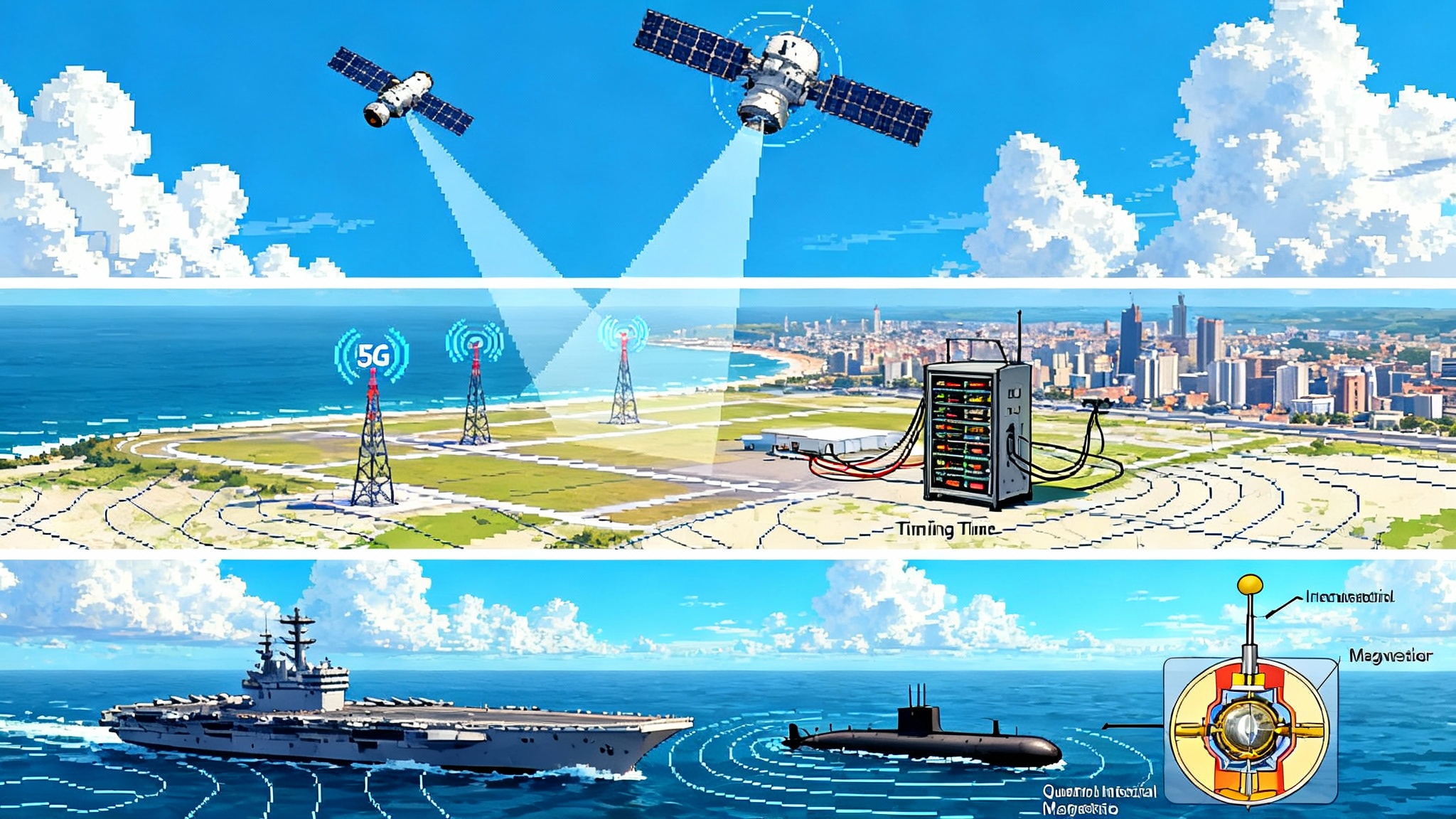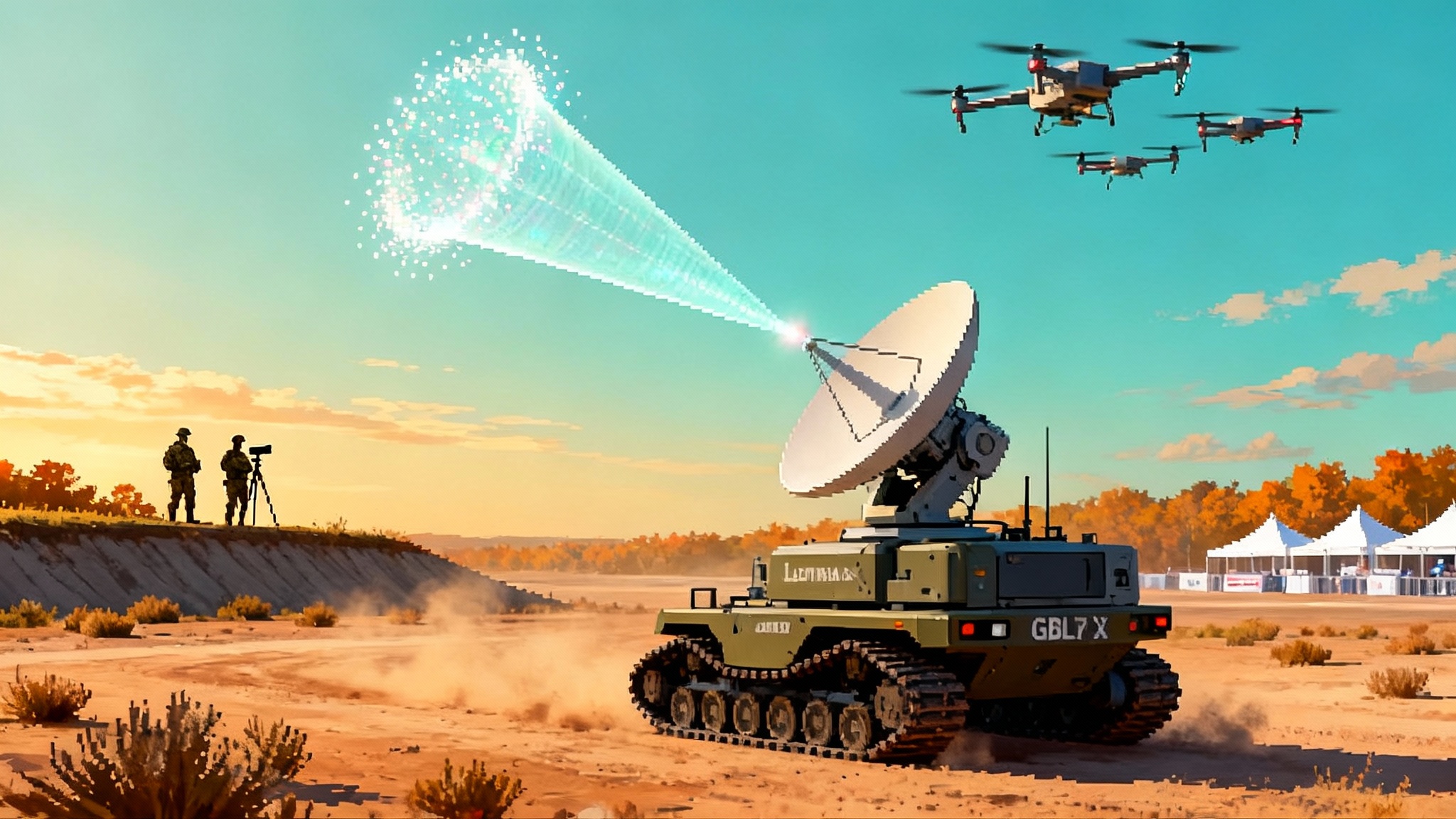Resilient PNT Goes Real: 2025’s Pivot Beyond GPS Begins
2025 is the year resilient positioning, navigation, and timing moves from slideware to steel. With a reprogrammable military nav satellite in orbit, LEO signals maturing, and quantum sensors entering field tests, commanders can harden targeting, autonomy, and blue-water ops.

The moment resilient PNT stops being theory
If you remember one thing from this year, make it this: resilient positioning, navigation, and timing is no longer a roadmap item. It is now flying. In August 2025 the first fully reprogrammable U.S. military navigation satellite reached orbit, designed to shape beams, update waveforms in flight, and act as a rapid-response augmentation to the aging Global Positioning System. That launch marked a practical turn in how the United States will fight through jamming and spoofing. See the official release on the NTS-3 reprogrammable satellite.
This article maps the layered architecture taking shape across space, terrestrial, and quantum domains. It also lays out near-term programs and what they unlock for swarms, long-range fires, and blue-water operations over the next 24 months.
The new layered architecture: three legs of one stool
Think of resilient PNT like a three-legged camping stool. Lose one leg and you can still balance for a while. Lose two and you are on the ground.
- Space layer: modernized medium Earth orbit and low Earth orbit signals with steerable beams and agile waveforms.
- Terrestrial layer: city and base area signals from ground towers, fiber-delivered time, and regional transmitters that penetrate indoors and under canopy.
- Quantum layer: onboard sensors that measure motion, gravity, and magnetic fields to dead-reckon precisely when radio signals are suspect.
The strength is in how these legs combine. A missile battery, a carrier strike group, or a swarm of uncrewed systems will not bet the mission on a single signal. They will blend them, cross-check them, and degrade gracefully.
Space: from monolithic GPS to agile, multi-orbit PNT
The headline is a geosynchronous navigation satellite that can be reprogrammed on orbit. Where legacy GPS satellites broadcast fixed waveforms, this class can push narrow, high-power regional beams, rotate to different codes, and conduct experiments that close the loop from threat to countermeasure.
Commercial low Earth orbit PNT services are maturing as well, offering higher power signals that are easier to receive in urban canyons and more resilient to local jamming. Together with government constellations and new transport layers such as the SDA’s LEO constellation rewires defense, fused receivers can accept or discard signals based on integrity instead of trusting a single source.
Terrestrial: ground signals and fiber time move from pilot to plan
Resilience improves dramatically when you do not rely on space at all. Two moves in 2025 stand out.
- Positioning over 5G waveforms: demonstrations on licensed spectrum show a path to 3D positioning and precise time wherever cellular infrastructure exists. Fused receivers can favor terrestrial signals when satellites are blocked or suspect, especially in dense cities, indoors, and under foliage.
- Policy tailwinds for complementary PNT: updated government profiles and conformance frameworks give program offices practical levers. Specify behaviors like spoofing detection, autonomous holdover, and multi-source integrity checks rather than just frequency bands.
On the timing side, fiber-delivered time services and wide-area LEO timing mean a microgrid, a shipyard, or a carrier’s battle network can keep clocks aligned even if skyward signals are a mess. Day to day, radios stay in sync, networks route deterministically, and weapons hit the window they were planned to hit.
Quantum: inertial and magnetic sensors get out of the lab
The third leg lives on the platform. Quantum-enhanced inertial sensors and magnetic navigation let an aircraft, a ship, or a missile measure motion and the environment precisely enough to dead-reckon when radios lie. The Defense Innovation Unit has begun structured field testing across inertial sensors, gravimetry, magnetic anomaly detection, and magnetic navigation. See the program note on DIU quantum PNT field tests.
On magnetic navigation, real-time demonstrations on large aircraft and continued Navy research into low-drift atom interferometers point toward operational trials. The technique uses the Earth’s magnetic field and anomaly maps as a reference, fusing sensitive magnetometers and machine learning to filter out vehicle noise.
What the next 24 months unlock
Swarms that do not blink under interference
Swarms and distributed uncrewed systems need three things to work under attack: a shared clock, a shared map, and a shared plan. A layered PNT stack checks all three boxes and complements how uncrewed fighters reset the cost curve.
- Shared clock: LEO timing and fiber-fed time servers keep radios and time-sensitive networking protocols synchronized to tens of nanoseconds.
- Shared map: magnetic and gravity-aided navigation let airborne and maritime swarms localize against the environment itself rather than a single radio signal.
- Shared plan: reprogrammable space signals enable shifts to alternate codes and regional beams, denying the attacker easy predictability.
The practical result is graceful degradation. If a swarm loses satellite signals, it falls back to terrestrial PRS-based positioning and onboard inertial and magnetic fixes while time stays tight enough to fuse sensors meaningfully.
Long-range fires that stay on track
For long-range fires, the layer cake reduces error growth during dead-reckoning and makes midcourse updates trustworthy.
- Pre-launch: ground units receive time from fiber or LEO timing, so the weapon’s clock and the fire control network start in lockstep.
- Boost and midcourse: quantum-aided inertial sensors reduce drift, while magnetic or celestial fixes correct error without relying on contested radio links.
- Terminal: when a regional military PNT beam is available, rejoin a hardened signal at the endgame to tighten circular error probable without long emissions.
Blue-water operations with radio silence
In the open ocean, radio silence is both a tactic and a necessity. Quantum inertial navigation keeps position and heading honest for days, while magnetic or gravity-aided fixes correct drift when the tactical situation allows. Reprogrammable space signals add an over-the-horizon option for brief updates. This dovetails with the rise of uncrewed fleets and distributed maritime ops.
Near-term programs and procurement moves to watch
- Reprogrammable navigation satellite experiments: track the one-year on-orbit experiment series. Action: require vendors to demonstrate compatibility with agile, regional-beam PNT signals. Ask for bench tests that simulate beam hopping and waveform changes.
- LEO PNT pilots: procure dual-receiver test kits and add LEO signals into your PNT filter. Measure anti-jam improvement in urban and maritime scenarios and log how often your filter accepts or rejects each signal family.
- Terrestrial 5G-based PNT: for bases and depots, plan small-area trials to cover GPS-denied indoor spaces and maintenance hangars, then feed that time to your radio networks.
- Quantum inertial and MagNav trials: nominate platforms for trials, write data rights into contracts, and insist on side-by-side comparisons against your current best inertial measurement unit and filter.
- Policy and standards: write government PNT profiles and conformance frameworks into statements of work as explicit verification artifacts, including spoofing detection, anomaly alarms, and holdover targets.
- Counter-jam posture: equip field units with low-cost spectrum monitors and mandate jammer incident reporting so engineering teams can retrain detection algorithms with fresh data.
How to architect for resilience now
- Multi-source PNT engine: buy receivers that fuse space, terrestrial, and onboard sensor inputs, and expose per-source integrity metrics. If your navigation solution is a black box, you cannot know when it is being fooled.
- Integrity before accuracy: configure filters to down-weight signals that fail cross-checks. If inertial predicts a turn that LEO and GPS disagree on, hold position until magnetic or visual odometry weighs in.
- Holdover clocks: specify oscillators that can hold time through your mission profile. A shipboard combat system may want miniature rubidium; a small drone can accept a high-grade oven-controlled crystal. Use measured drift, not brochure values.
- Test like the adversary: red-team with record-and-replay spoofing, wideband jamming, and urban multipath. Require contractors to demonstrate recovery behaviors such as automatic switchover to terrestrial PNT, MagNav reversion, and resynchronization to fiber or LEO time once clear.
The limits to respect
- Map quality rules MagNav: magnetic anomaly maps are not equally detailed everywhere. Budget for survey campaigns on likely routes, or MagNav performance will look like a blurry chart.
- Size, weight, and power still bite: early quantum sensors are shrinking fast, but you will not put a lab rig on a micro unmanned aerial vehicle. Choose platforms that can host the first generation.
- LEO is stronger, not magic: higher power and geometry help, yet a determined, nearby jammer can still deny a pocket of airspace. Plan for tactical counter-jamming and fast rerouting.
- Reprogrammable is not invulnerable: signal agility raises the bar for attackers, but it also raises the bar for your own test and certification. Budget for waveform updates and regression testing.
The bottom line
By late 2027, a typical U.S. unit should be navigating and timing off a mesh of sources: trusted GPS when available, a reprogrammable military augmentor when needed, one or more commercial LEO signals for timing and urban coverage, terrestrial PRS-based positioning indoors, and quantum-aided inertial and magnetic fixes onboard. The shift is not about perfection. It is about refusing to bet the mission on a single signal from the sky. The units that plan and procure to this layered reality now will own the advantage when interference becomes routine.







